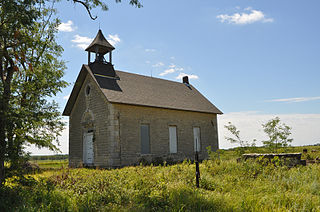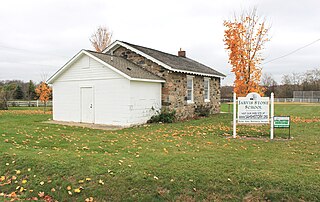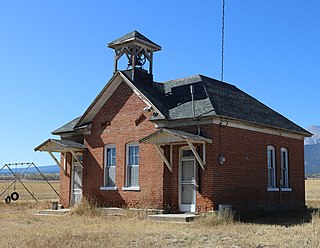
One-room schools were commonplace throughout rural portions of various countries, including Prussia, Norway, Sweden, the United States, Canada, Australia, New Zealand, the United Kingdom, Ireland, and Spain. In most rural and small town schools, all of the students met in a single room. There, a single teacher taught academic basics to several grade levels of elementary-age children. While in many areas one-room schools are no longer used, it is not uncommon for them to remain in developing nations and rural or remote areas. Examples include remote parts of the American West, the Falklands, and the Shetland Islands.

Jefferson County School District R-1 is a school district in Jefferson County, Colorado. The district is headquartered at the Jeffco Public Schools Education Center in West Pleasant View, an unincorporated area of the county near Golden in the Denver-Aurora-Lakewood, CO Metropolitan Statistical Area. Jeffco Public Schools serves almost 81,000 students in 166 schools. It is the second-largest school district in Colorado, having been surpassed in 2013 by Denver Public Schools, which has an enrollment of approximately 87,000.
The Cherry Creek School District 5, also known as Cherry Creek Public Schools, is a school district based in western Arapahoe County, Colorado. The superintendent is Scott Siegfried. It consists of elementary, middle, and high schools. The district headquarters are in Greenwood Village.

Avilla R-13 School District or Avilla R-XIII School District is a rural public elementary and middle school located in Avilla, Missouri, USA. For grades kindergarten through eight, it is the only school in the district. In the 2000 census, the district schooled 153 pupils and had 13 teachers on staff. Programs include basketball and agriculture, and the school boasts a low student to teacher ratio. Avilla is located at 37°11′38″N94°07′44″W, in Jasper County ten miles east of Carthage, Missouri on MO Route 96 and four miles west of the Lawrence County line.

The Craigflower Manor and Craigflower Schoolhouse are National Historic Sites of Canada located in View Royal, British Columbia and Saanich near Victoria. The centerpiece of each historic site is a 19th-century building — a manor and schoolhouse commissioned by the Hudson's Bay Company to provide education and lodging for their employees. Built as part of the agricultural community Craigflower Farm, the buildings served as a focal point for the community into the modern era; they remain open to the public today as museums devoted to the colonial history of Victoria.

The Schoolhouse is an exhibit building at Shelburne Museum in Shelburne, Vermont. It was originally located in Vergennes, Vermont.
William Abbe (1800–1854) was an Iowa state senator and is believed to have been the first white settler in Linn County, Iowa. Originally from Ohio, he traveled west in search of land in 1836. Little is known about Abbe until this time. Abbe Creek, on which he established his homestead, still bears his name today. A one-room school house was established on the homestead site in 1856 and still stands today bearing the name of Abbe Creek School. He died in 1854 in California and was buried in Sacramento.

Ourant's School is a one-room schoolhouse located on Ourant Road, east of Deersville, Ohio. The schoolhouse was placed on the National Register on 1994-03-17.

Fishing Creek Schoolhouse is a historic school located in the Villas census-designated place, of Lower Township, Cape May County, New Jersey, United States. The schoolhouse was built in 1888 and added to the National Register of Historic Places on March 6, 1980.

Venado is an unincorporated community in Sonoma County, California, United States, and is located about 12 miles west of Healdsburg, along Mill Creek Road, below the north slope of Knoll Ridge, on the south bank of Gray Creek, at an elevation of 1,102 feet. The name is Spanish for deer or venison, and the community had a post office from 1921 to 1941. Venado was devastated by the Walbridge Fire in 2020, part of the larger LNU Lightning Complex fire. The Walbridge Fire destroyed many homes and structures in the area, including the Venado Post Office and Daniels School.
The Greenfield Park One Room Schoolhouse is located in the town of Wawarsing in Ulster County, New York, United States. This one-room schoolhouse was built in 1830 and was home to grades one through eight. It was operated by one teacher and one school trustee. Its former students restored it to its present condition after forming the "Greenfield Park Historical Association" in 1960.

Sodom Schoolhouse is a historic octagonal school in West Chillisquaque Township, Northumberland County, Pennsylvania, United States reportedly built about 1812, 1835, or 1836 and used until 1915. It is located in a rural area on Pennsylvania Route 45 near several Scotch-Irish communities: the "small group of houses" formerly known as Sodom, which was about a mile east of the hamlet of Montandon, and about 3 miles east of a small town, Lewisburg.

In the late 19th and the first half of the 20th century, one room schools were commonplace throughout rural Kansas. In most rural schools, all of the students met in a single room. One room meant one teacher who taught basic reading, writing, and arithmetic to both boys and girls of all grades. When one-on-one instruction was necessary, the teacher would call a student forward to the recitation desk.

Perrinsville School is a historical site in Wayne County in Westland, Michigan. Perrinsville is a one-room schoolhouse that is located on Warren Road and Cowan Road. What is now the city of Westland used to be called the Village of Perrinsville in the 1830s. The main residential streets, Perrin and Liberty are still there today and Perrinsville was first settled by Thomas Dickerson in 1831. The Perrin brothers opened a sawmill in 1832 and several other business opened to help the village of Perrinsville reach peak activity in the 1850s.

The Jarvis Stone School, alternately known as the South Salem Stone School, is a defunct school in Salem Township, Washtenaw County, Michigan, built in 1857, and restored in the years leading up to 2007.

The Greenfield School in West Allis, Wisconsin was built as a two-room school in 1887, but in an elegant Romanesque Revival style unusual for such buildings. It was added to the National Register of Historic Places in 2006.

Forest Grove School No. 5 is an historic building located near Bettendorf, Iowa, United States. It was listed on the National Register of Historic Places in 2013.
Marshalltown Community School District (MCSD) is a public school district headquartered in Marshalltown, Iowa.

Des Moines Township No. 7, also known as Cole School, is a historic building located northeast of Boone in rural Boone County, United States. The brick one-room schoolhouse was completed in 1888. The use of brick suggests the people in this area were either people of some wealth or there was a larger population who could draw on a broader base of financial resources. Student records were not kept until the year after the school opened. At that time there were 19 students who were between the ages of 5 and 16. Nellie Harvey was the first teacher, and she and those who came after her worked with the students from first grade to eighth. In addition to being a schoolhouse, the building also served as a voting place, a community center, and a storm shelter. As the number of farm families in the area diminished the enrollment in the school declined. Educational leaders began to advocate for better educational offerings and improved school buildings. In 1920 the Iowa General Assembly passed laws to improve rural schools. During the Great Depression more families left the farms and the school closed in 1933. Two of the students who attended the school when it opened had sons in the final class of eight students.

The Gas Creek School, near Nathrop, Colorado in Chaffee County, Colorado, was built in 1909. It was the only school in Chaffee County School District No. 20 and it operated from 1909 to 1958. It was listed on the National Register of Historic Places in 2018.




















